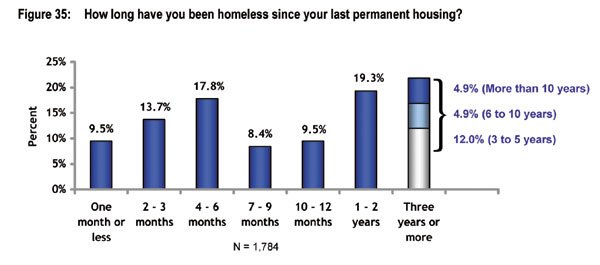Gilroy
– County residents may be asked to pay a tax to build and
maintain housing for the chronically homeless population as part of
a plan to end homelessness in 10 years.
Gilroy – County residents may be asked to pay a tax to build and maintain housing for the chronically homeless population as part of a plan to end homelessness in 10 years.
“We’re talking about a tax or a fee or a combination of both, but I just don’t see anyway around it,” said Margaret Gregg, homeless concerns coordinator for Santa Clara County. “You not only need money the first time, but you need it every year. We can’t solve this problem with a bake sale mentality.”
According to the final results of an exhaustive, street-by-street count and survey of the homeless population taken over the winter, there are at least 2,600 people living on the street considered to be chronically homeless, meaning they’ve been without permanent housing for a year or have had four episodes of homelessness in the last three years.
A task force of service providers and county and city officials has determined that the best way to serve that population is with a “housing first” model that provides housing without requiring troubled residents to seek treatment for the hallmarks of homelessness such as drug and alcohol addiction and mental illness.
“It’s a very progressive, very energetic plan, but it’s very challenging because it’s going to cost some money,” Gregg said. “The folks we’re talking about can not afford housing so someone is going to have to come up with rental subsidies and they’re going to have to be deep.”
Advocates say housing first is attractive because it provides stability that helps people deal with the other troubles in their lives, as proven by successful housing-first programs in New York, San Francisco and Contra Costa County.
“The lesson of the survey is that we have not done enough,” said Poncho Guevara, director of communications for South County Housing. “If you look at the hierarchy of human needs, a stable housing situation is fundamental to people being able to cleanup the other issues in their lives. The solution is permanent, affordable housing with support services.”
There are already housing first programs in San Jose and Palo Alto that are successful but illustrate the challenges of paying for housing-first models. Tenants who receive social security must pay 30 percent of their income in rent. Other tenants need not pay any rent, though they are assisted in getting on some form of general assistance. Landlords are paid through rent vouchers issued by local government.
The task force has not figured out how much money it would need on an annual basis to house and provide support services to the chronically homeless, but it will be more than can be raised on an ad hoc basis.
“Everything is in the incubation stage when it comes to funding,” said Mark Walker, president and CEO of United Way Silicon Valley and chairman of the task force’s funding committee. “We are looking at several steps, one of which is a long-term sustainable funding source. We can not expect to solve this problem simply through contributions from interested individuals and companies.”
The task force has given itself a year to figure out the best way to finance and implement its plan and will conduct surveys to gauge support for various tax measures. Past efforts have turned up little support for raising taxes to combat homelessness.
Maury Kendall, of the Housing Trust of Santa Clara County, said that surveys taken in the middle of the technology boom showed that support didn’t merit taking a similar proposal to the ballot. The housing trust, which is helping finance construction of a new transitional housing and a shelter on Monterey Road, relies on private donations and has raised $25 million since 2000. He said housing trusts up and down the state are struggling to find reliable sources of income.
“There’s a recognized need for a dedicated funding stream, but not an agreement that it has to be a tax,” Kendall said. “They haven’t come up with creative solutions. There needs to be more research and discussion.”
Walker said that winning support for a tax measure will depend on the public agreeing that a tax dedicated to housing will save money in the long run by easing the strain on a variety of other social services used by homeless people.
“This is not insurmountable if people agree that this is one of the top health and human service issues and the economic impact of not fixing the problem is huge,” Walker said. “We can do a lot better job of creating awareness of the issue and get it to the top of the mind of the public and donors. That will be critical regardless of the funding mechanism.”
The first step in raising public awareness is publication of the street count and survey. Conducted in the pre-dawn hours on two days last December, the count discovered 7,646 homeless people in the county. That figure, combined with survey data, led homeless experts to conclude that a total of 20,338 people in the county are homeless at some point during the year. The census found 420 homeless in Gilroy and 36 in Morgan Hill.
“The number of folks in South County was particularly startling,” Guevara said. “It sends a message that we need to be doing more. They may not be on our doorstep, but they’re in our communities. The count found them. For a community that prides itself in taking care of its own, there are a lot of folks who don’t have a place to sleep.”
In addition to the census, more than 1,700 homeless people responded to surveys that the county has used to build a demographic snapshot of the homeless population. The typical homeless resident is a man who has been in the county for more than a decade, has a drug or alcohol addiction and is not receiving any government assistance.
At least 16 percent of the people counted in the census were single women and about 11 percent of the survey respondents had children under the age of 18.
The most striking racial disparity was among black homeless people. Blacks make up just 2.8 percent of the county population, but more than 20 percent of the homeless population. The white and Hispanic homeless counts are roughly in line with the general population. There are relatively few Asian homeless.
The final draft of the survey and the plan will be presented to the county board of supervisors for adoption May 3. Both reports will then be available to the public.















